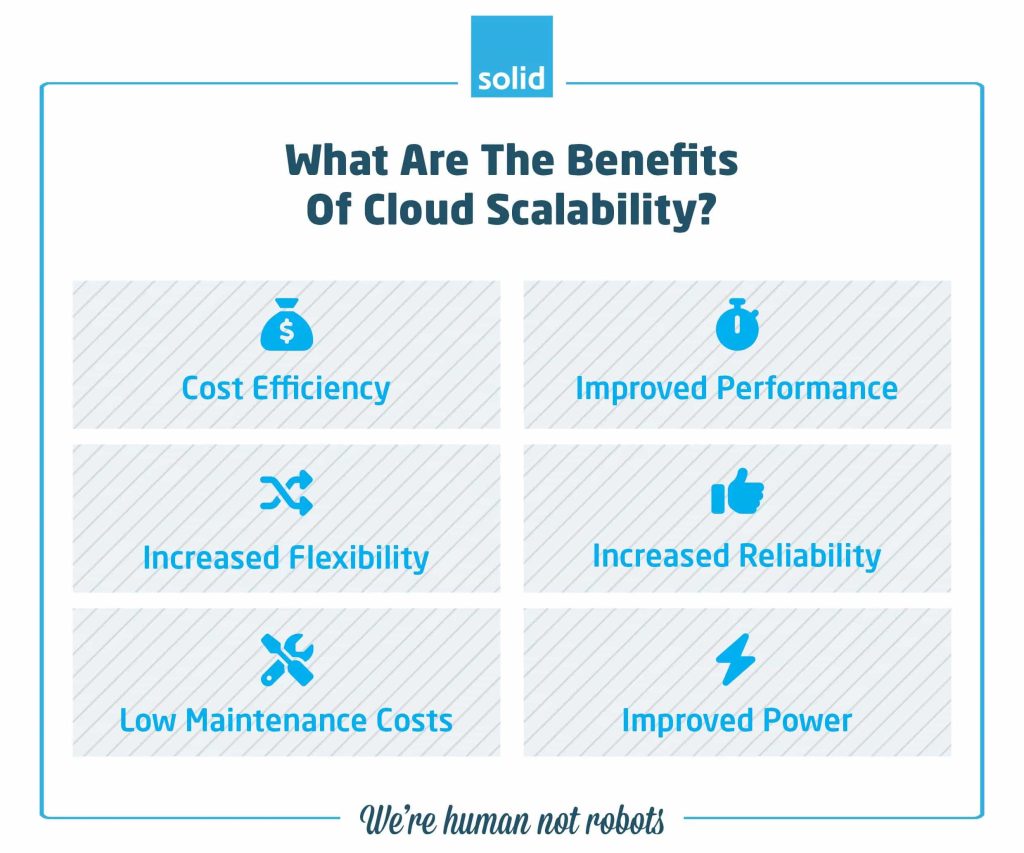
Introduction
What is Cloud Scalability?
Cloud scalability refers to the ability of cloud computing services to efficiently adapt to varying resource demands. Businesses can seamlessly adjust their IT resources—like computing power, storage, and bandwidth—according to their requirements. Imagine a scenario where an e-commerce company sees an unexpected spike in traffic during a holiday sale. With cloud scalability, they can instantly increase their server capacity to handle customer demand without any downtime.
Cloud scalability can be divided into two main categories: vertical scaling, which involves adding more power to existing machines, and horizontal scaling, where more machines are added to share the load. This flexibility allows companies to maintain optimal performance while reducing the risk of overprovisioning or underutilization of resources.
Benefits of Cloud Scalability
The advantages of cloud scalability are numerous, and they can greatly impact a business’s efficiency and cost structure:
- Improved performance: Allocating resources on-the-fly ensures that applications run smoothly without lag during peak times.
- Cost-effectiveness: Organizations only pay for the resources they use, which can lead to significant savings.
- Enhanced agility: Businesses can quickly adapt to market changes and customer demands, enabling faster decision-making.
- Streamlined operations: Automating resource allocation allows teams to focus on strategic initiatives rather than mundane maintenance tasks.
By embracing cloud scalability, companies position themselves for growth and success in a rapidly evolving digital landscape, as highlighted in our discussions at TECHFACK.

Understanding Scalability in Cloud Computing
Scalability Defined
Scalability in cloud computing refers to the system’s capacity to handle an increasing amount of work or its potential to be enlarged to accommodate that growth. To illustrate, consider a small start-up that initially runs its operations on a single server. As the business attracts more customers, that single server might become insufficient. Scalability enables the company to efficiently adjust its resources to meet higher demands without causing disruptions or major capital investments.
This adaptability is essential for businesses aiming for sustainable growth. It’s about having the right infrastructure to support both current and future operational needs, ensuring that they are not just equipped for today but are also prepared for tomorrow’s challenges.
Types of Scalability
There are two primary types of scalability that organizations leverage in cloud computing:
- Vertical Scalability (Scaling Up): This involves adding more power (CPU, RAM) to the existing server. Think of it as upgrading your existing car to a faster model. It’s straightforward but comes with limitations, as there’s only so much you can add to a single machine.
- Horizontal Scalability (Scaling Out): This method adds more machines into your pool of resources. Imagine owning a fleet of cars instead of just one. You can distribute the load among all vehicles, allowing for greater efficiency and redundancy.
By understanding these types, businesses can choose the right approach to scalability that aligns with their strategic goals, ensuring effective resource management and service delivery.

Importance of Cloud Scalability for Business Growth
Scalability Impact on Business Operations
Cloud scalability plays a pivotal role in enhancing business operations by enabling companies to respond quickly to changes in demand. For instance, consider a mobile app that experiences a surge in downloads due to a viral trend. With scalable cloud architecture, the app can dynamically allocate additional servers, ensuring that users enjoy a seamless experience without frustrating lags or crashes.
The impact on operations can be seen in several key areas:
- Flexibility: Businesses can modify their resource allocation in real-time, adjusting to seasonal trends or sudden market shifts.
- Reliability: Higher traffic volumes and user demands can be met without compromise on service quality, contributing to customer satisfaction and retention.
- Speed: Rapid adjustments reduce downtime, allowing teams to focus on innovation rather than battle operational hiccups.
Cost-Efficiency with Cloud Scalability
Cost efficiency is another compelling reason for adopting cloud scalability. Traditional IT infrastructures often require significant investment in hardware that may remain underutilized during off-peak periods. Cloud scalability eliminates this challenge by allowing companies to pay only for the resources they consume.
Key cost-saving benefits include:
- Pay-as-you-go model: Organizations can scale up during peak seasons and scale down afterward, ensuring they only pay for what they use.
- Reduced capital expenses: With minimal need for physical infrastructure, companies can redirect funds into growth-oriented strategies rather than maintenance.
- Optimization strategies: By carefully monitoring usage, businesses can identify inefficiencies and optimize their resource allocation.
This unique blend of operational agility and financial prudence makes cloud scalability an essential component for any business aiming to thrive in today’s competitive landscape.

Factors Affecting Cloud Scalability
Network Performance
When discussing cloud scalability, network performance cannot be overlooked. A robust, high-speed network is essential for optimal scalability. If a business’s internet connection is sluggish or inconsistent, it may struggle to effectively scale resources when demand spikes.
For example, consider an online streaming service that experiences a sudden influx of viewers during a live event. If the network cannot handle this surge, users may encounter buffering issues or dropped connections, damaging the brand’s reputation.
Key elements of network performance to consider include:
- Bandwidth: Sufficient bandwidth ensures quick communication between servers and users during high-demand periods.
- Latency: Low latency is crucial for delivering data in real-time, impacting user experience significantly.
- Redundancy: Having backup connections can prevent failures and ensure uninterrupted service during peak times.
Data Center Locations
The geographic locations of data centers also heavily influence cloud scalability. The closer the data centers are to end-users, the lower the latency and the better the user experience. A company serving clients across various regions should consider multiple data centers to facilitate lower response times.
Consider a global e-commerce platform: if its primary data center is located far from a specific market, customers in that region will experience delays during transactions.
Factors influenced by data center locations include:
- Regulatory compliance: Different regions may have specific data sovereignty laws affecting storage and processing.
- Disaster recovery: Strategically placed data centers can enhance backup and recovery capabilities during unforeseen incidents.
- Cost implications: Operations may be affected by local energy costs and infrastructure stability.
Overall, by understanding these factors, businesses can design a more resilient, scalable cloud infrastructure that adapts seamlessly to market demands.
Strategies for Ensuring Seamless Business Growth with Cloud Scalability
Auto-Scaling Techniques
Auto-scaling is a smart strategy that enables businesses to automatically adjust the number of active servers based on current demand. This means that during peak traffic times, additional servers can be spun up instantly, while during quieter periods, excess servers can be reduced—optimizing resource usage and costs.
For instance, a social media platform that experiences sudden surges in activity during global events can leverage auto-scaling to ensure every user has a smooth experience. Key practices in auto-scaling include:
- Monitoring metrics: Set up thresholds for CPU usage, memory consumption, or request counts to trigger scaling actions.
- Setting cooldown periods: This prevents rapid scaling operations from causing undue stress on resources, leading to better performance.
- Defining scaling policies: By establishing fixed guidelines, auto-scaling becomes more efficient and predictable.
Load Balancing Approaches
Load balancing complements auto-scaling by distributing incoming traffic across multiple servers to avoid overwhelming any single server. It’s like a traffic cop managing a busy intersection, ensuring that data flows smoothly without congestion.
There are different load balancing strategies to consider:
- Round Robin: This method systematically distributes requests to all servers in a list, ensuring an even load.
- Least Connections: Directs traffic to the server with the fewest active connections, optimizing resource use.
- IP Hashing: This approach routes requests based on the client’s IP address, ensuring that specific users consistently connect to the same server for a stable experience.
By implementing these strategies, businesses can create a robust and flexible cloud infrastructure that supports seamless growth. This means they can effortlessly adapt to changes and ensure their systems can handle both surges and downturns, paving the way for continued success in a competitive environment.

Best Practices for Implementing Cloud Scalability
Monitoring Resources
To maximize the benefits of cloud scalability, businesses must implement effective monitoring techniques to keep track of their resources. Just as a pilot continuously checks instruments during a flight, businesses should continuously monitor their cloud infrastructure’s performance. This enables proactive adjustments and helps prevent potential issues before they escalate.
Monitoring can be broken down into several key components:
- Performance metrics: Keep an eye on CPU usage, memory consumption, and network traffic to ensure resources are effectively utilized.
- Alerts and notifications: Setting up alerts for unusual patterns in resource usage allows teams to react quickly to unexpected spikes or drops.
- Analytics tools: Utilize cloud monitoring platforms like AWS CloudWatch or Azure Monitor to gain valuable insights and enable better decision-making.
Disaster Recovery Planning
Disaster recovery planning is essential in ensuring business continuity, especially when scaling operations. Imagine a scenario where a sudden data breach or hardware failure occurs—having a disaster recovery plan means your business can bounce back without significant downtime or data loss.
Effective disaster recovery strategies involve:
- Data redundancy: Keeping backup copies of your data in multiple locations ensures that you’re covered in case of localized failures.
- Regular testing: Conduct frequent drills and simulations to ensure that your recovery plans are effective and that your team knows their roles during an emergency.
- Documentation: A clearly outlined recovery procedure helps guide teams through the process, reducing confusion during high-stress situations.
By adhering to these best practices, businesses can not only ensure seamless scalability but also create a resilient cloud environment ready to thrive even in the face of adversity. Proper resource monitoring and robust disaster recovery plans are integral to fostering sustained growth and operational excellence.

Case Studies: Successful Implementation of Cloud Scalability
Company A: Scaling for Peak Traffic
Let’s take a look at Company A, an online retail giant, known for its annual flash sales. During these events, traffic surges dramatically, often overwhelming their servers. Previously, they would face downtime and slow response times, resulting in frustrated customers and abandoned carts.
To tackle this, Company A adopted cloud scalability and implemented an auto-scaling strategy. By configuring their infrastructure to automatically add servers during expected peak times, they managed to handle the traffic spikes effectively. Key measures included:
- Predefined scaling policies: They set rules based on traffic patterns, allowing quick adjustments as demand surged.
- Load balancing: Distributing incoming traffic across multiple servers ensured stability and optimized performance.
The result? A seamless shopping experience during promotional events, a significant increase in sales, and strong customer satisfaction scores.
Company B: Adapting to Market Demands
Company B, a fintech startup, faced fierce competition in a rapidly changing market. To stay relevant, they needed a scalable solution that allowed them to introduce new products quickly. By leveraging cloud scalability, they were able to:
- Quickly develop and deploy applications: They used cloud resources to rapidly build new features and services, responding to market feedback in real time.
- Utilize data analytics: With scalable cloud resources, they analyzed customer data to identify trends and anticipate demands.
This adaptability enabled Company B to launch multiple successful products within a short time frame, significantly expanding their market share and establishing themselves as innovators in their field.
These case studies highlight how cloud scalability not only improves operational efficiency but also empowers companies to face challenges head-on and thrive in dynamic environments.

Future Trends in Cloud Scalability
Edge Computing and Scalability
As we look to the future, edge computing stands out as a significant trend influencing cloud scalability. Instead of relying solely on centralized data centers, edge computing brings computation and data storage closer to the location where it’s needed. This can lead to immediate benefits, especially for applications requiring real-time processing.
For example, consider a smart city deployment with countless IoT devices collecting data. By processing data at the edge, decisions can be made instantly—like adjusting traffic signals based on current conditions—without the delay associated with sending information back to a distant cloud server.
Some benefits of edge computing in cloud scalability include:
- Reduced latency: Processing data closer to its source significantly decreases response times.
- Improved bandwidth efficiency: By handling data locally, businesses can save on bandwidth costs and reduce the need for extensive cloud resources.
- Enhanced security: With sensitive data processed locally, the risk of exposing it during transmission is diminished.
AI-driven Scalability Solutions
Another exciting trend is the integration of Artificial Intelligence (AI) in scalability solutions. AI can transform how businesses approach cloud scalability by learning from usage patterns and making predictive adjustments.
Imagine an e-commerce platform that experiences sudden demands during a flash sale. AI algorithms can analyze historical data to forecast traffic spikes and automatically adjust resources ahead of time. This leads to:
- Proactive resource allocation: Instead of waiting for peak usage, resources can be allocated based on predictions.
- Enhanced decision-making: AI provides actionable insights on resource utilization, helping businesses optimize their cloud expenditures.
- Self-healing systems: In cases where issues arise, AI can automatically resolve problems or adjust resource allocations without human intervention.
By embracing these innovations, businesses can stay ahead of the curve, ensuring that their cloud scalability strategies are dynamic, efficient, and capable of meeting the challenges of tomorrow.
Conclusion
Recap of Cloud Scalability Benefits
As we’ve explored throughout this article, cloud scalability is an essential component for businesses looking to thrive in today’s fast-paced digital landscape. It offers a flexible and efficient way to manage resources, ensuring that organizations can react promptly to changing market demands and customer behaviors. Key benefits of cloud scalability include:
- Operational Flexibility: Easily scale resources up or down as needed, allowing for efficient management of workloads.
- Enhanced Performance: Businesses can provide consistent user experiences by eliminating downtime during peak usage.
- Cost Efficiency: Pay for only the resources required, reducing waste from over-provisioning and optimizing operational budgets.
Advantages of Embracing Scalability
Embracing scalability isn’t just about resource management; it’s about positioning your business for long-term growth and resilience. Companies that adopt scalable cloud solutions can:
- Accelerate Innovation: Rapidly develop and deploy new products or features, adapting quickly to market trends.
- Improve Customer Satisfaction: By ensuring optimal performance, organizations boost user satisfaction and retention.
- Future-Proof Operations: Scalability enables businesses to adjust to unforeseen circumstances—like sudden demand spikes or shifts in consumer behavior—ensuring they remain competitive.
In conclusion, the strategic implementation of cloud scalability leads to not only sustained growth but also operational excellence. As organizations continue to navigate the complexities of the digital era, adopting scalable solutions will be critical for success. By leveraging the right strategies, tools, and insights, businesses can thrive today and tomorrow, positioning themselves for a brighter future.

